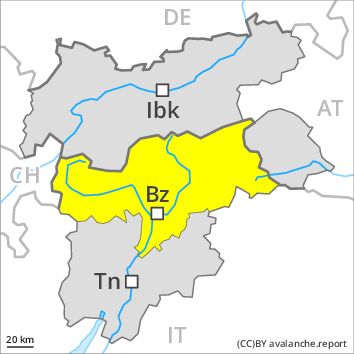Regions
Sexten Dolomites, Eastern Pfunderer Mountains, Durreck Range, Western Rieserferner Mountains, Val Müstair Alps, Western Deferegger Alps, Langtaufers, Ortler Range, Schnals Ridge, Southern Stubai Alps, Ulten Valley, Southern Zillertal Alps and High Tauern, Eastern Nonsberger Alps, Northern Dolomites of Fiemme, Saldurn-Mastaun Ridge, Gröden Dolomites, Texel Mountains, Prags Dolomites, Sarntal Alps, Western Pfunderer Mountains

Danger level
Avalanche Problem
Wind-drifted snow above the treeline, N-NE-E-SE-W-NW
Gliding snow above 2600m, N-NE-E-SE-S-SW-W-NW

Moderate, level 2.
The fresh and older wind slabs can still be released especially on very steep west, north and southeast facing slopes. Caution is to be exercised at their margins in particular, in particular in gullies and bowls, and behind abrupt changes in the terrain. Single backcountry tourers can release avalanches only in isolated cases, including dangerously large ones. As a consequence of warming and solar radiation a moderate danger of moist and wet snow slides will be encountered in some regions. Especially bases of rock walls are unfavourable. Below approximately 2600 m more small and medium-sized gliding avalanches are possible.
Snowpack
The wind slabs have formed in particular in gullies and bowls, and behind abrupt changes in the terrain. They are in some cases extensive and to be assessed critically. In some cases the various wind slabs have bonded still only poorly together. In little used backcountry terrain the avalanche situation is a little more dangerous. The old snowpack remains moist below approximately 2000 m.
Tendency
Moderate, level 2.